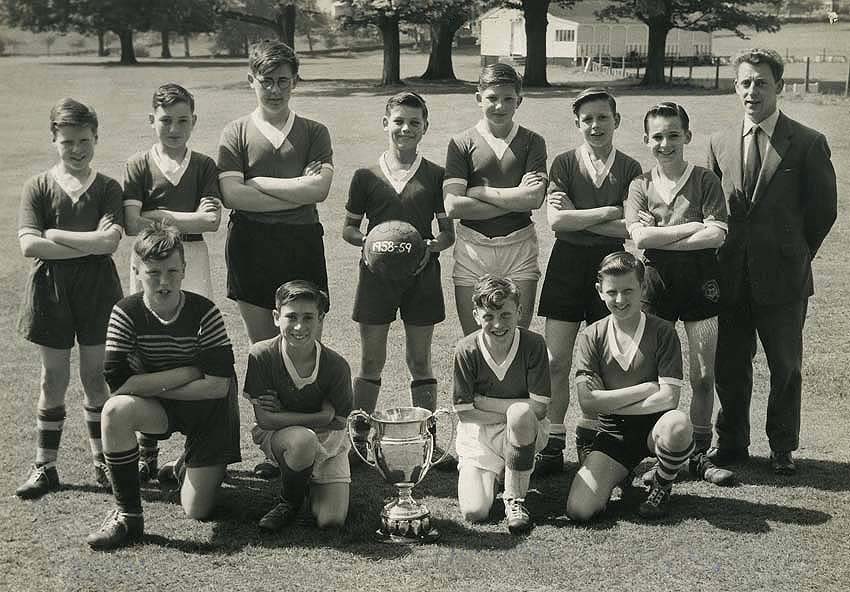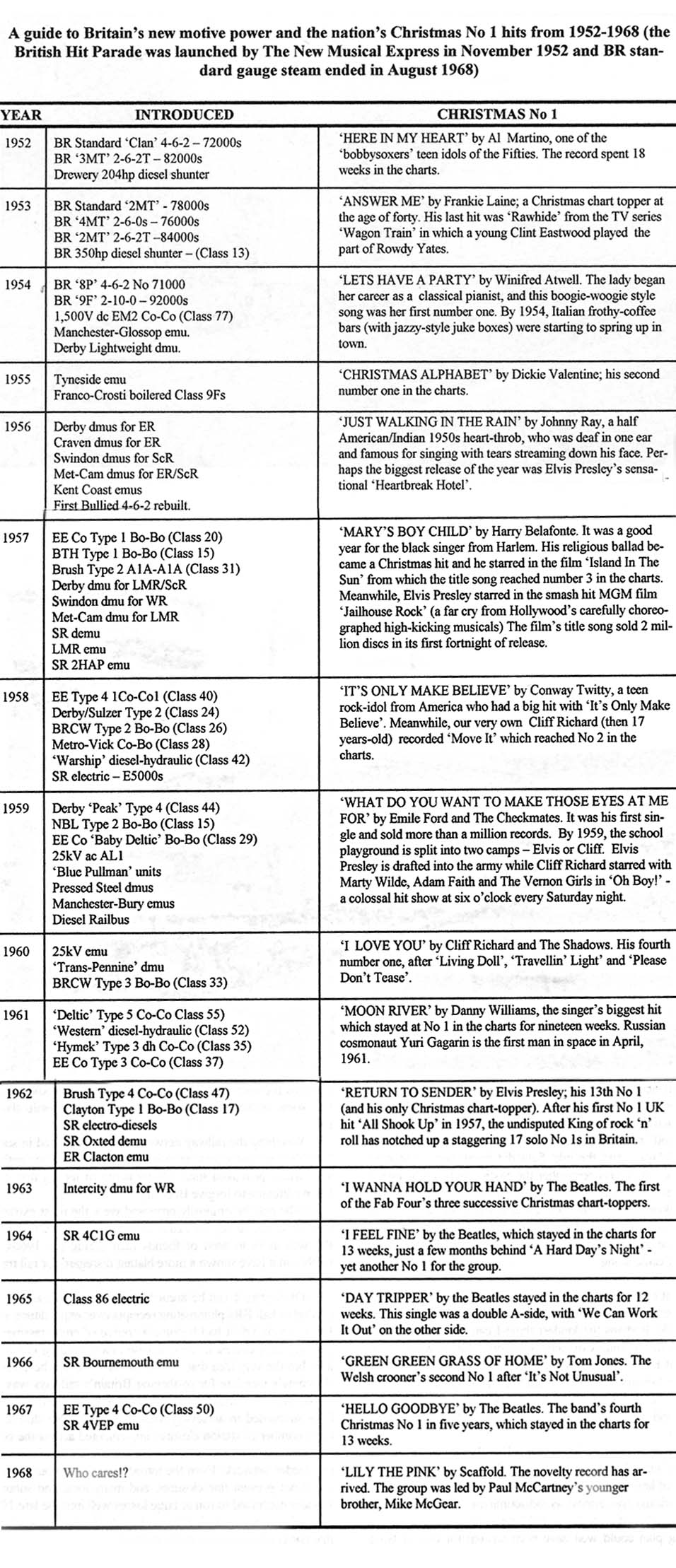I was born in the late Forties - a post-war 'baby-boomer', no less, so I wasn't around to witness the Second World War, or listen to Winston Churchill's rousing oratories on steam radio. His rendition of - 'Never in the field of conflict was so much owed by so many to so few...' makes my pulse race in much the same way as the sight of a streamlined Gresley A4 'streak' thundering along the flat racing ground north of York, or a Collet 'King' doing battle on the South Devon banks, a Stanier 'Duchess' storming Shap, or a gleaming 'Spam Can' dashing through the Kent countryside with a Continental boat train.
I remember taking a trip to the 'Flicks' and watching the British Movietime News. It was usually narrated by a rather grandiloquent-spoken gentleman - all frightfully, frightfully - which imbued me with the belief that I was somehow inferior because of the way we spoke 'up north'.
The plain-spoken folk I grew up with punctuated their sentences with 'Eeeeh, bah gum' or 'Ecky thump, like!' I never heard anyone embellishing their voices with snooty flourishes like those plummy-voiced oiks from down south.
Still the old newsreel footage gave me a chance of seeing something of the LNER's Apple Green livery, the LMS's Maroon and the Southern Railway's Malachite Green, albeit in black and white, so it's refreshing to see engines on preserved lines decked out in original liveries.
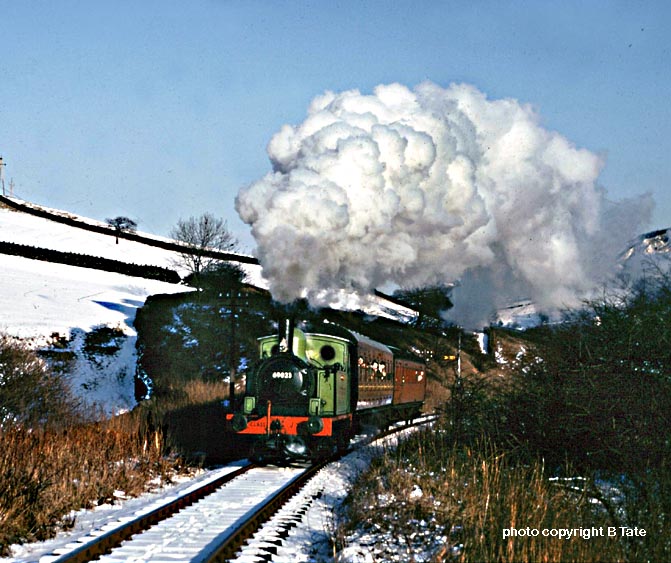
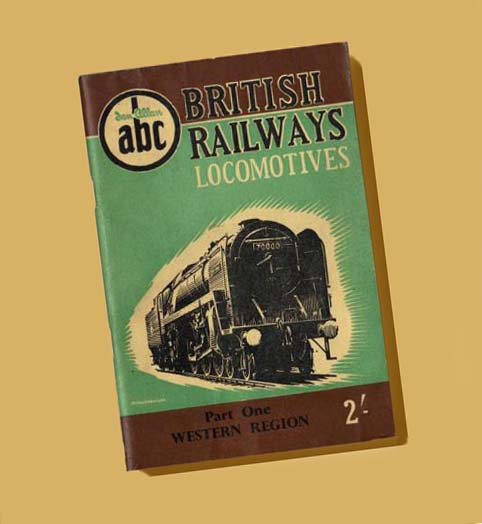 (Above-Left-Below) There must have been lots of ruddy cheeks as NER Class J72 0-6-0T No 69027 makes a spirited climb to Oxenhope in snowy weather on the Keighley & Worth Valley Railway. (Left) Keeping apace with the then current scene, Ian Allan Publishers was standardising its abc Locospotter Book covers too. AN Wolstenholme's evocative line drawing of BR Standard 7MT No 70000 Britannia, was reproduced on the cover of all four BR Regions - in this case the Western Region, with the appropriate WR chocolate livery in two bands top and bottom. (Below) A grimy BR Standard Class 3MT No 77014 at Guildford Loco in the 1960s. Mac's photos can also be found the the 'Southern Region Enginemen' pages and his 'Rail Cameraman' page.
(Above-Left-Below) There must have been lots of ruddy cheeks as NER Class J72 0-6-0T No 69027 makes a spirited climb to Oxenhope in snowy weather on the Keighley & Worth Valley Railway. (Left) Keeping apace with the then current scene, Ian Allan Publishers was standardising its abc Locospotter Book covers too. AN Wolstenholme's evocative line drawing of BR Standard 7MT No 70000 Britannia, was reproduced on the cover of all four BR Regions - in this case the Western Region, with the appropriate WR chocolate livery in two bands top and bottom. (Below) A grimy BR Standard Class 3MT No 77014 at Guildford Loco in the 1960s. Mac's photos can also be found the the 'Southern Region Enginemen' pages and his 'Rail Cameraman' page.
It's a crying shame that my generation missed the 'Big Four' railway companies which were amalgamated to form the new British Railways. Quite simply, we were born too late, or perhaps we should think ourselves lucky to have been born at all, depending on one's point of view of the outcome of the war?
The baby boom was due, in large measure, to the need for financial stringencies and an abstinence from family planning, but as soon as the war with Germany was over, the nation's bedsprings were soon twanging away to a celebratory orgy of passion as the menfolk returned from service overseas.
This bulldog spirit continued well into the late Fifties, but the erstwhile class system had changed little from the old colonial days of the British Empire. The stuck-up socialites still subscribed to their assumption about the right order of things which meant that a person was ranked by their role in the workplace and expected to snap to attention and address everyone else as their betters. Still no matter where they came in the social pecking order, the working class was proud to be British and proud to be themselves.
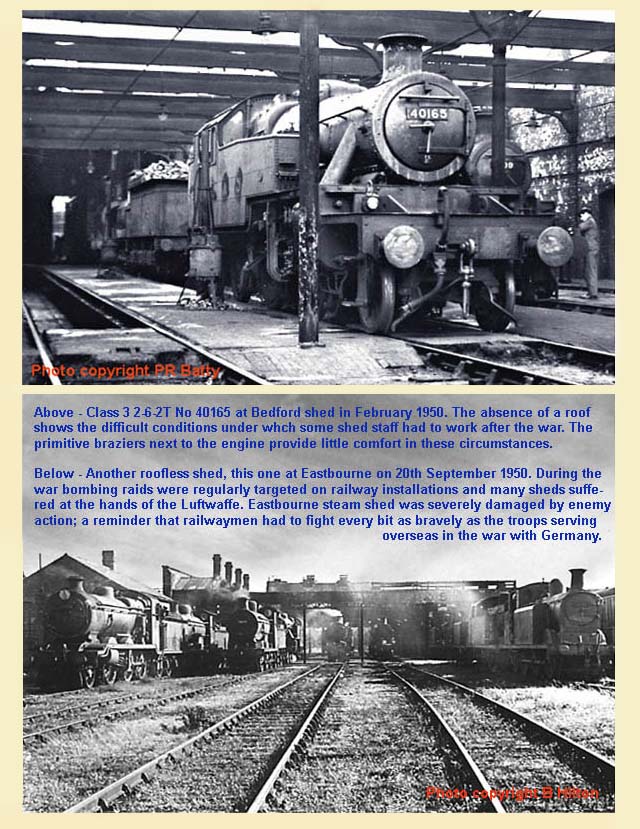 1955 was a landmark year for steam fans; construction of the new BR Standard Class 9F was well advanced - by the end of the year 38 had entered traffic, followed in 1956 by 45, 56 in 1957, 62 in 1958, 15 in 1959, and the final 3 in 1960. The 9F was by far the most numerous of the Standard classes, with 85 going to the ER, ten to the NER, 56 to the WR and 100 to the MR - total built 251. Two hundred and fifty one?
1955 was a landmark year for steam fans; construction of the new BR Standard Class 9F was well advanced - by the end of the year 38 had entered traffic, followed in 1956 by 45, 56 in 1957, 62 in 1958, 15 in 1959, and the final 3 in 1960. The 9F was by far the most numerous of the Standard classes, with 85 going to the ER, ten to the NER, 56 to the WR and 100 to the MR - total built 251. Two hundred and fifty one?
It does beg the question why such large numbers were built when their usefulness was limited to so few years? But then the BTC's decision to develop existing steam power had been made as long ago as 1948; a decision greatly influenced by the parlous state of Britain's economy and the low capital cost it would take to build a series of new steam locomotives, in preference to the huge expenditure required to get large-scale dieselisation off the ground.
Within eight years, however, the plan was radically changed. No sooner had the first batch of 32 BR Class 9Fs been completed at Crewe Works in December 1954, and the BTC announced the Modernisation Plan, the emphasis of which was the total replacement of BR steam. .
However, there was no concession for patriotism when post-war financial hardship meant that most families had to struggle to make ends meet. The 1950s was a 'make do and mend' era, and essential food such as bacon, meat, butter, cheese, eggs, tea and sugar were still in short supply. By the end of rationing, however, the stoicism of the 'points' system had levelled the playing field, and the class divide - once as clear-cut as the finest crystal - began to wane in the Sixties.
But I'm getting ahead of myself - returning to the immediate post-war years, in spite of Churchill's rousing oratories, the Tories were surprisingly defeated in the 1945 General Election and the nation now pinned its hopes on the Labour Party's manifesto which promised the end of poverty, better housing and free treatment in health care. At the same time, acrimonious debate began echoing around the corridors of Whitehall over the Government's plan for nationalising Britain's key industries, including the former 'Big Four' railway companies - the LMSR, LNER, GWR and SR.
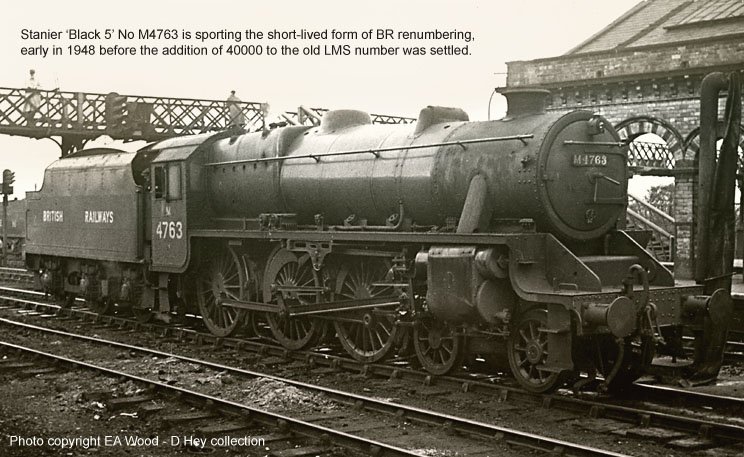
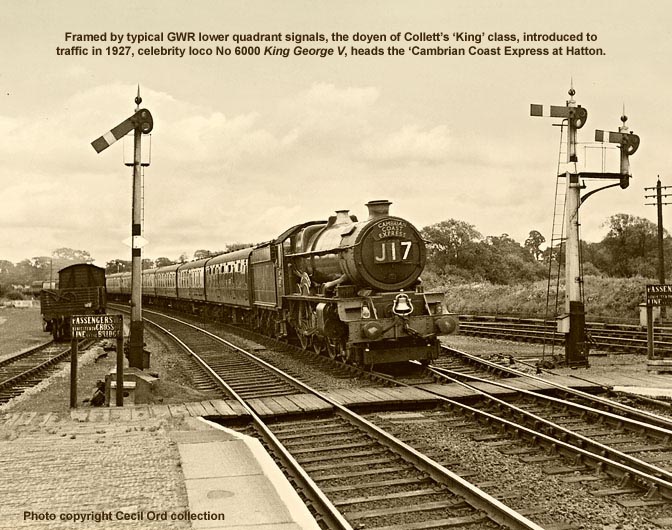

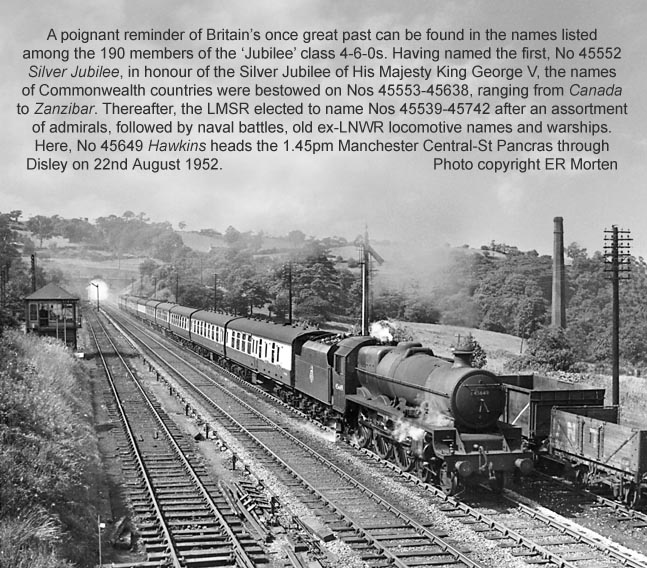
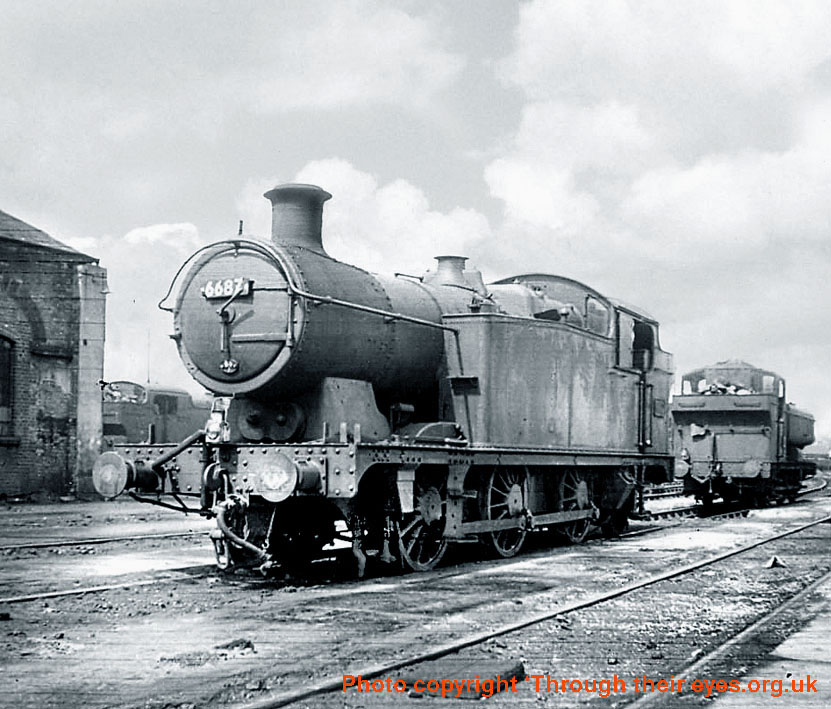
(Above) The WR's Class 66XX 0-6-2T was specifically designed for local passenger services on the steeply-graded valley lines in South Wales. With a power classification of 5MT, they were a robust engine for their size, but the exceptional overhang of the boiler and smokebox at the front end gave them an altogether unbalanced look. Here, No 6687 (above) and No 6608 (below) await their next turn of duty at Cardiff Cathays shed (88A).Some of the original steam loco photos featured on this page were provided by 'Through their eyes.org.uk' and are available on a DVD containing 2,800 high resolution scans produced from original negatives, slides and photos. Click here for link to this interesting site. I am not affiliated in any way with the sale of DVD's.
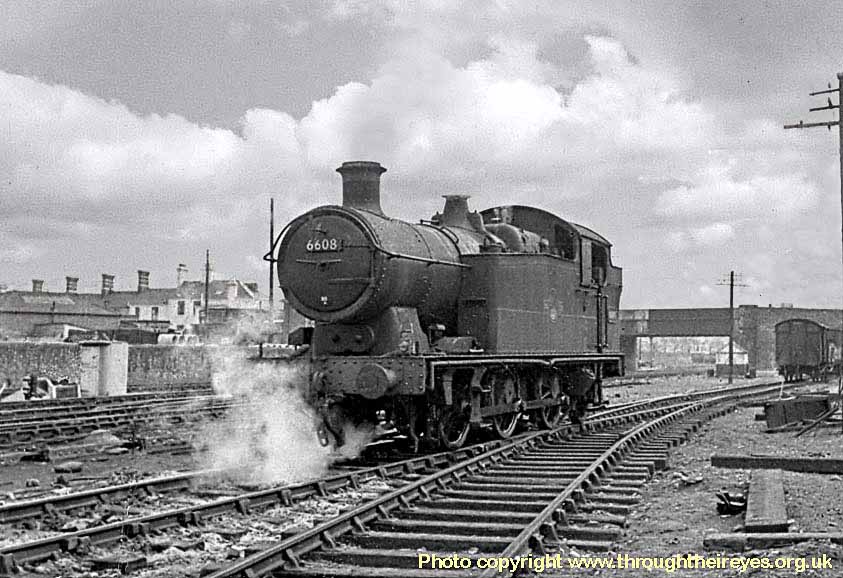
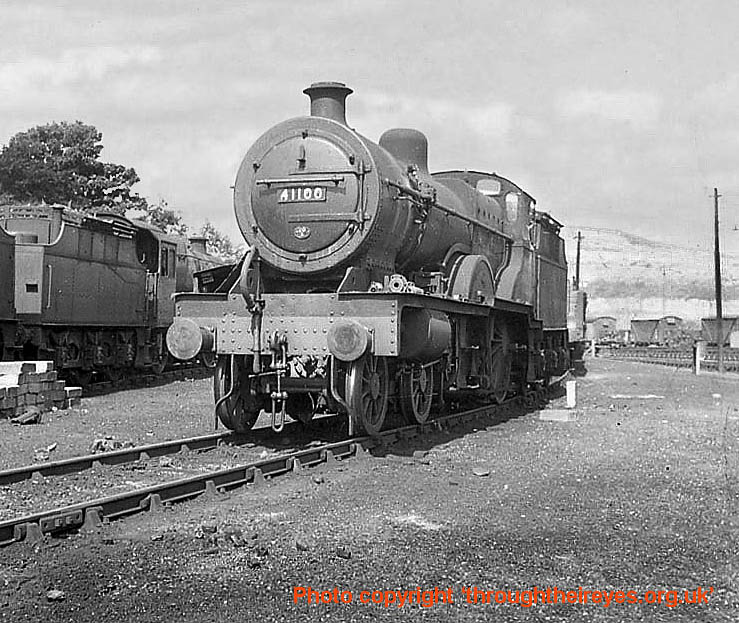
(Above-Below) The once-numerous Compound Class 4P 4-4-0 became early candidates for withdrawal and few survived beyond the Fifties. Here, No 41100, devoid of connecting rods and front driving wheels awaits a decision on its future at Barrow shed (11A). (Below) A long-time resident of Llandudno Junction shed (6G) was Stanier 3MT 2-6-2T No 40130.
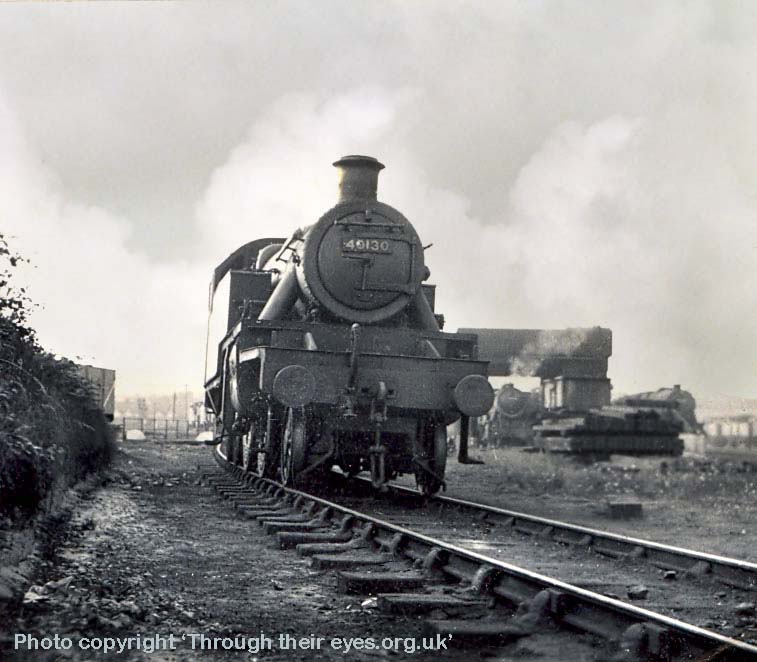
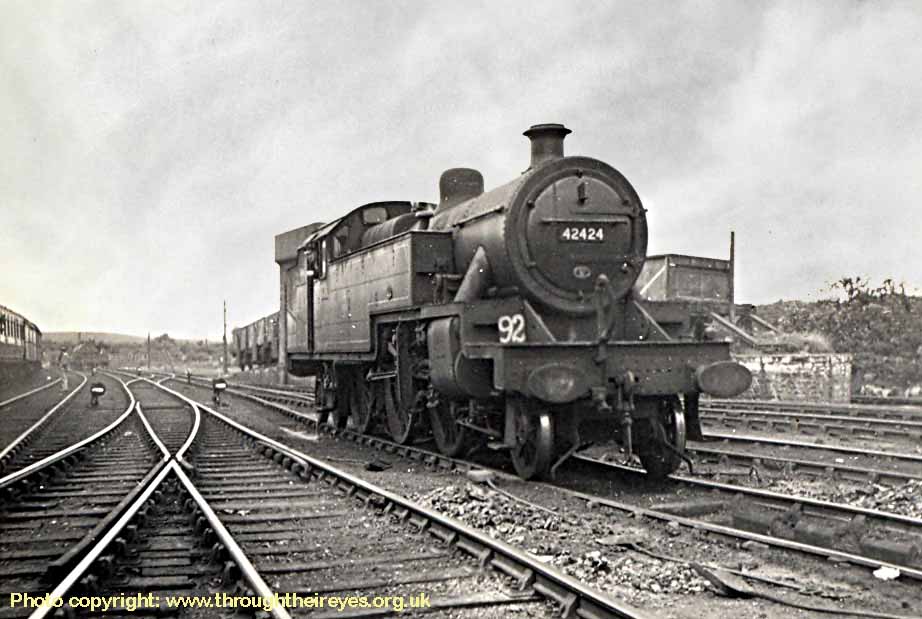
(Above) Fowler Class 4MT 2-6-4T No 42424, the last member of the class fitted with side windows to the cab, awaits its next banking duty at Oxenholme shed (10C).
By the mid-Fifties, a renewed sense of optimism began to sweep the country as British industry emerged from the post-war doldrums, and many firms were offering more congenial working conditions than at any time since before the war. At long last, prosperity seemed just around the corner, yet money was still tight and improvements to the home were painfully slow. To think that we lived in a house without electricity until 1956 is an indictment of those times.
In fact, the standard of living was bleak on so many levels that it's hard to imagine a modern-day family - pampered by all the creature comforts that we now take for granted - being asked to live in a house without electricity. A Fifties housewife had to be Olympian fit to get through the daily grind of domestic chores. Many homes still had gas lighting that 'popped' when the 1d slot meter ran out; the outside toilet froze during the winter - and families had to share the hot water in a tin bath, which, for the last one in, was marginally cleaner than a sheep dip. Less than half of British households possessed a bathroom, yet in 1959, Harold Macmillan, then Tory Prime Minister, elected to office for the third time, uttered the immortal words - 'You've never had it so good.'
(Below) Blast from the past! Although this website is about train spotting, many people have suggested that I should personalize it a bit more. Fair enough...old school days are now a distant memory for a legion of post-war baby-boomers. This photo of Horsforth (Featherbank) Secondary 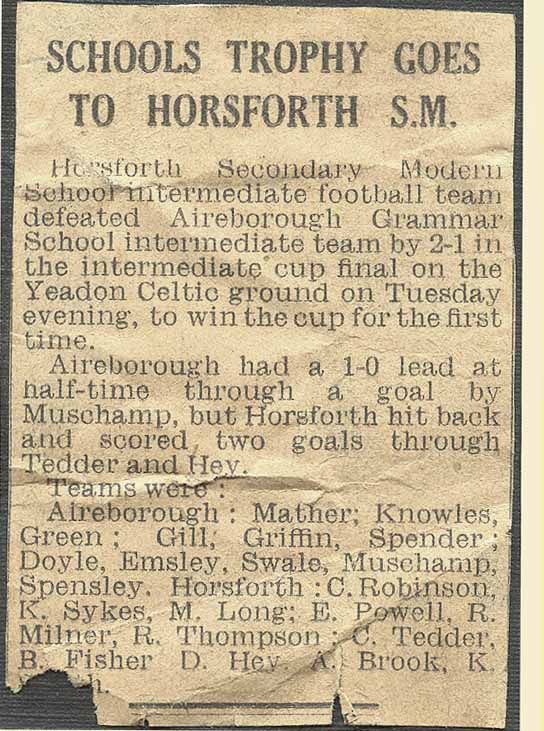 Modern School Intermediate football team during the 1958-59 Season is a case in point.
Modern School Intermediate football team during the 1958-59 Season is a case in point.
The picture appeared in the local paper 'Horsforth News' under the heading 'SCOOLS TROPHY GOES TO HORSFORTH SM.' The reprobates in the photo are: back row left to right - Eric Powell, Robert Thompson, David Hey, Allan Brook, Kiffin Sykes, Brian Fisher, Ken Smith and Mister Thackray (Sir'). In the front row left to right are - Chris Robinson, Colin Tedder, Michael Long and Raymond Milner.
However, with the passing of years I was not sure about the details so I contacted my old spotting chum Robert Thompson (second left on the back row), who writes: 'David, you have the names correct as far as I can recall, but as you say it's over 50 years ago - frightening really! The teacher was Mister Thackray...that said I cannot recall his first name because we always referred to him as Sir. I remember him providing the promised fish 'n' chip supper if we won the cup. A group of us cycled down to Low Lane Fisheries and we had it at teacher Chris Danson's house on Outwood lane. You may also remember we clubbed together to buy him a wallet. Looking back you never really appreciate how good those days were and how lucky we were to be involved. Thanks for the memory!'
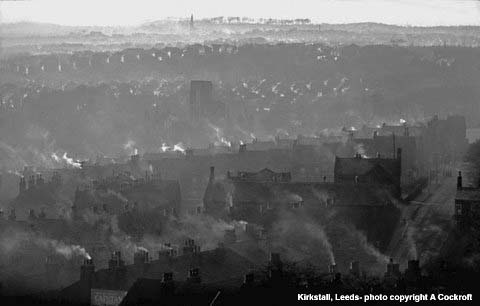 Cloth caps, mill chimneys, cobbled streets and rows of back-to-back terraced housing are the traditional images that people associate with the north. In this scene of Kirkstall (Horsforth St Margarets Church spire can be seen in the distance), the acrid smoke hanging ponderously over back-to-back rooftops evokes memories of the 'peasouper' fogs of the Fifties when road traffic was brought to a halt and street lighting was swallowed up in the gloom. The first campaign to clean up the atmosphere began in Manchester in 1954 when compensation was paid to domestic consumers and industrial users who switched from coal to smokeless fuel, electric or gas heating. In 1956, the Clean Air Act was passed which brough an end to the great London smogs - the last recorded being in the 1962-63 winter.
Cloth caps, mill chimneys, cobbled streets and rows of back-to-back terraced housing are the traditional images that people associate with the north. In this scene of Kirkstall (Horsforth St Margarets Church spire can be seen in the distance), the acrid smoke hanging ponderously over back-to-back rooftops evokes memories of the 'peasouper' fogs of the Fifties when road traffic was brought to a halt and street lighting was swallowed up in the gloom. The first campaign to clean up the atmosphere began in Manchester in 1954 when compensation was paid to domestic consumers and industrial users who switched from coal to smokeless fuel, electric or gas heating. In 1956, the Clean Air Act was passed which brough an end to the great London smogs - the last recorded being in the 1962-63 winter.
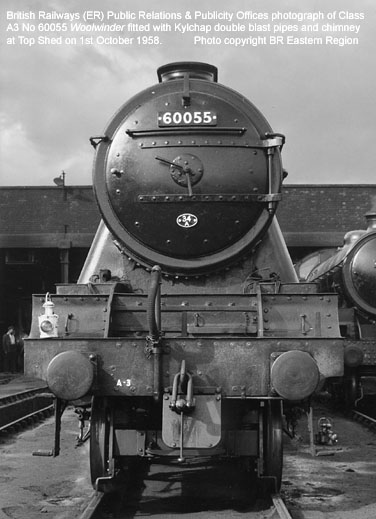
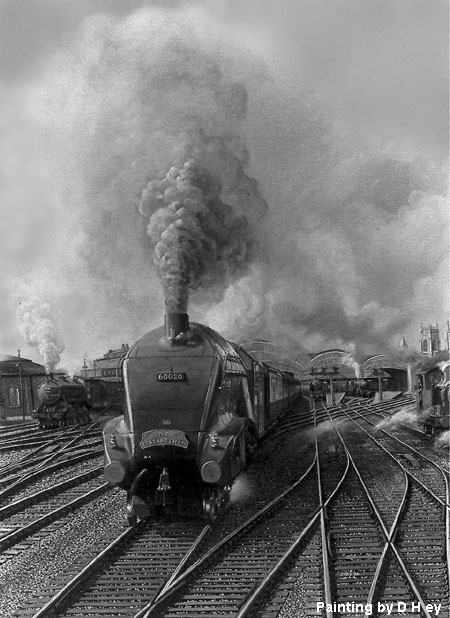
Over the points, over the points! During the Fifties, both the ITA and BBC were required to close down for an hour between six and seven o'clock to allow mothers to put children to bed. This hour, known as 'Toddlers' Truce', became the subject of considerable lobbying in Parliament before the Government finally 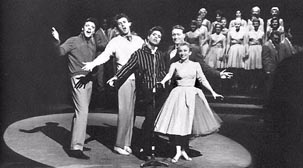 caved in and the ban was officially lifted on 16th February 1957. At 6pm. the BBC screened a five minute news bulletin, followed by the 'Six-Five Special'. On the opening night, the show's host, Pete Murray announced - 'Welcome aboard the Six-Five Special. We've got almost a hundred cats jumping here, some real cool characters to give us gas. So just get on with it and have a ball…' Hold on a mo! - Did we really talk like that? The '6-5 Special' regulars included The King Brothers, The Mudlarks and Don Lang and his Frantic Five who recorded the show's theme tune; guest appearances were made by Lonnie Donegan, Tommy Steele, Vince Eager, Jim Dale and Marty Wilde. Not to be outdone, ITV launched 'Oh Boy' in direct competition in September 1958 - copying the same format and featuring the Dallas Boys, Vernon Girls and Lord Rockingham's X1 who reached No 1 with 'Hoots Mon'. A young 19 year-old Cliff Richard appeared on the first show and two weeks later entered the charts with his first UK hit - 'Move It.'
caved in and the ban was officially lifted on 16th February 1957. At 6pm. the BBC screened a five minute news bulletin, followed by the 'Six-Five Special'. On the opening night, the show's host, Pete Murray announced - 'Welcome aboard the Six-Five Special. We've got almost a hundred cats jumping here, some real cool characters to give us gas. So just get on with it and have a ball…' Hold on a mo! - Did we really talk like that? The '6-5 Special' regulars included The King Brothers, The Mudlarks and Don Lang and his Frantic Five who recorded the show's theme tune; guest appearances were made by Lonnie Donegan, Tommy Steele, Vince Eager, Jim Dale and Marty Wilde. Not to be outdone, ITV launched 'Oh Boy' in direct competition in September 1958 - copying the same format and featuring the Dallas Boys, Vernon Girls and Lord Rockingham's X1 who reached No 1 with 'Hoots Mon'. A young 19 year-old Cliff Richard appeared on the first show and two weeks later entered the charts with his first UK hit - 'Move It.'
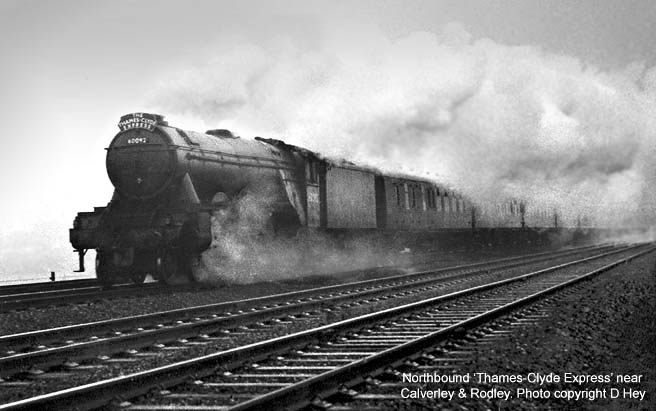
 Of course, my generation was too young to have any political perspective of our own, and any idealistic views were left to a new breed of writers dubbed the angry young men, whose gritty kitchen sink dramas led to the first rumbling of discontent in the Sixties.
Of course, my generation was too young to have any political perspective of our own, and any idealistic views were left to a new breed of writers dubbed the angry young men, whose gritty kitchen sink dramas led to the first rumbling of discontent in the Sixties.
It wasn't until 1963 that I began to have any political grievances to speak of. It began with the appointment of Dr Richard Beeching as the new BR chairman, though it wasn't the Government's niggardly regard to public spending that I objected to; it was their choice of a little-known ex-ICI executive whose mismatched enthusiasm for slashing the rail network caused hardship on a grand scale.
The sheer lunacy of Whitehall bureaucrats has seldom been more ruthlessly exposed than in their treatment of BR because like so many other nationalised industries taken under Government control, the railway network suffered political interference of the worst kind...but more of that later.
Getting back to childhood days, the spirit of self-reliance we enjoyed during the Fifties means relatively little to today's youngsters, who seem only interested in themselves and their rights rather than in their duty and responsibilities. We now have a self-confident, liberated bunch of youths who are contemptuous of past traditions, yet keen to embrace new ideas and the latest technology.
There's nothing wrong with that, of course, although many cynics would argue that playing computer games for hours on end is doing children more harm than good. Not that I'd dream of denying a child the pleasure they get from playing virtual-reality computer games.
After all, mastering keyboard skills is an essential part of a modern education, but I do wonder at the long-term effects from sitting only inches away from an EPA-polluted computer screen in darkened bedrooms for long long periods at a time…take my then ten-year old grandson, Sam, for example. I phoned him up to ask how he was.
"I'm stuck up a tree," he said breathlessly.
Bless! I had interrupted him in the middle of playing a game on Playstation 2, but he was out of puff? Now there has to be something wrong when, at the click of a mouse, a small boy can engage an opponent in a game of jiu-jitsu or kung-fu - zapping the enemy to a pulp with an arsenal of laser guns, bazookas, rocket launchers, and ground-to-air ballistic missiles armed with nuclear warheads. Wham-bang, wallop! Armageddon. You're dead mate! It seems there's no larking about in cyberspace, is there?
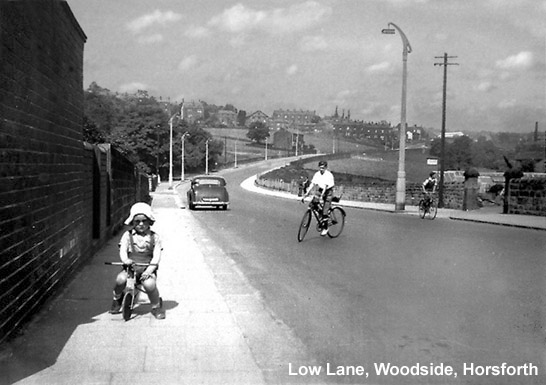
(Above-Below) The everyday spectacle of steam trains on my local line was barely worth a second glance to the local residents of Woodside in Horsforth, with the exception of this tiny infant (above). This is me in stylish aviator sun specs and silly bonnet, taking a break from gazing out of my bedroom window looking out for engines. I remember the steady procession of 'stoppers' and 'non-stoppers', but the most memorable train was the regal-sounding 'Queen of Scots', consisting of one train daily in each direction between London Kings Cross and Glasgow Queen Street. The swanky train was composed of flat-sided chocolate and cream Pullman cars with distinctive vestibule ends, each containing recessed doors, oval windows, even polished handrails and each car had the fine feudal Pullman coat of arms and a feminine name on the side. Witnessing the passage of the northbound 'Queen of Scots' on my way home from Woodside Infants School was the highlight of the day because the train was usually headed by a 'namer' - one of the Gresley Class A3 Pacifics based at Leeds Neville Hill shed or Gateshead shed on Tyneside. I must have seen Trigo, Harvester and Gainsborough on Pullman duty countless times, yet I never tired of watching them. Sadly, by the time I began serious railway photography in the Sixties, the Pullman roster was in the hands of the EE Co Type 4s, but I did manage to get a shot of Class A3 No 60084 Trigo (below) heading the northbound train over the Leeds Ring Road at Horsforth.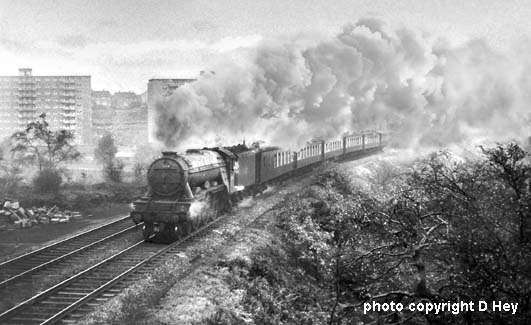
Childhood memories...saved by the 7 o'clocker!
Elsewhere on this website, I mention 'copping' my first 'streak' No 60001 Sir Ronald Mathews at Horsforth station between Leeds and Harrogate. It was the defining moment which kick-started my spotting days The A4s were spectacularly streamlined, with a wedge-shaped front - and fast. But above all else, their Crosby tri-tone whistles gave out a distinctive, melodious chime, which was music to the ears of this five year-old, who lived in a house overlooking the railway line in Woodside, Horsforth. I couldn't wait to see the two  Sunday night expresses (one in each direction) both headed by the strikingly handsome streaks. The booked time for the 'down' train was around 7pm which coined its nickname the 7 o'clocker and the 'up' train was called the '8 o'clocker' for the same reason.
Sunday night expresses (one in each direction) both headed by the strikingly handsome streaks. The booked time for the 'down' train was around 7pm which coined its nickname the 7 o'clocker and the 'up' train was called the '8 o'clocker' for the same reason.
Mention of the 7 o'clocker takes me back to post-war days when national pride was at its height. Everyone felt good about themselves, yet there was a growing sense that Britain was no longer the mighty Commonwealth leader of old. Instead the country had become a second-rate power status, struggling with a succession of balance of payment deficits and a sterling crises, causing a run of currency restrictions, cuts in social spending and a reduction in our overseas obligations. Quite simply, we had won the war, but somehow become the poor relation of Europe.
But a lot of changes were taking place in the post-war Fifties, including Britain's policy on the use of nuclear arms. The West had armed itself with a deadly arsenal of intercontinental ballistic missiles; this gave Britain the capability of 'nuking' the whole of Russia - or any other country, for that matter; indeed for those people still nursing bad memories of the conflict with Germany, a 3rd World War was a disaster just waiting to happen.
The 'bomb' wasn't a new phenomenon, of course. Back in 1945, Emperor Hirohito of Japan surrendered to the allies when the United States vaporized the city of Hiroshima with an atomic bomb called Little Boy, followed by a second atomic bomb Fat Man - who in hell dreamed up these names? - which wiped out the city of Nagasaki on August 9th.
Flushed by its success, the Atomic Energy Commission in the Nevada desert started work on an even bigger, better bomb - an atomic bomb that could hold the temperature long enough to fuse the nuclei of an hydrogen atom to trigger a 'super bomb', 1,000 times more destructive than all the bombs dropped on Japan.
On May 21st 1952, the Americans exploded their first hydrogen bomb over the Bikini atoll in the Pacific. The test shot, code-named 'Cherokee' was detonated at precisely 5.51 am local time - 6.51 p.m. Sunday BST. 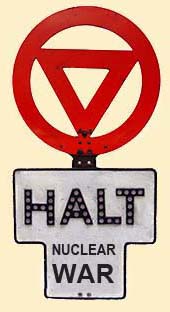 How do I know? I was hiding under the kitchen table at the time. It was my mother's idea. Tuning into the BBC Light Programme, she had been listening to a group of anti-nuclear protesters lambasting the Americans for meddling with forces they didn't understand - 'Did you hear that?' she gasped, 'The only way they can detonate a hydrogen bomb is by tapping into the same source of thermonuclear energy as our sun."
How do I know? I was hiding under the kitchen table at the time. It was my mother's idea. Tuning into the BBC Light Programme, she had been listening to a group of anti-nuclear protesters lambasting the Americans for meddling with forces they didn't understand - 'Did you hear that?' she gasped, 'The only way they can detonate a hydrogen bomb is by tapping into the same source of thermonuclear energy as our sun."
"They'll need long extension lead," quipped my dad; subtlety was so not his style!
Mum was mortified. In her awful imagination, she feared the bomb could split the Earth's crust, boil the Earth's oceans, blow away the Earth's atmosphere - it could create a chain reaction of such cataclysmic proportions and destroy the whole of mankind - "This could be the end of the world," she said mournfully and hit the home-made rhubarb wine from the pantry…
When Sunday evening came, we crawled under the kitchen table and peered dolefully at the clock ticking away the last seconds of our lives - "Oh, look at the clock - the big hand is nearly at ten!" she said.
I didn't want to look...I badly wanted to go to the toilet.
Then, with only seconds to go, I heard the melodious chimed-whistle of a 'Streak' on the Sunday-night seven o' clocker wafting across the valley. It couldn't have happened at a better time. It was as if the driver had given the 'all clear' signal, which, for this terrified youngster - 'babbing' his pants - came as a huge relief.
S'funny what you remember from childhood...
However, the reports sent by observers from the Pacific test site were far from funny! They described the hydrogen bomb's luminosity as being brighter than 500 suns. It was followed by a colossal pillar of fire that soared into the sky at incredible speed, then an iridescent mushroom cloud spewed upwards and outwards until, more than an hour later, it appeared to envelop the entire Earth. For any youngster to be burdened with such an image of mass destruction was, to put it mildly, scary - and hiding under the kitchen table 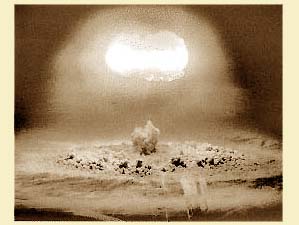 seemed a puny way to defend oneself. Indeed, the Government's official guideline for protection against a nuclear strike was equally appalling.
seemed a puny way to defend oneself. Indeed, the Government's official guideline for protection against a nuclear strike was equally appalling.
Experts believed that people in the blast area 'could become ill' (the quotation marks are mine) for as much as three months if exposed to radiation, so the public was advised to stay indoors to avoid radioactive fall-out.
As it turned out, the Government's duplicity was about as two-faced as you can get, for we now have access to 50 year-old Government documents which reveal how Whitehall ministers contemplated Armageddon with an almost sinister coolness. One file estimated the likely number of deaths during an atomic war in each British city - from 2,000 in Plymouth through 127,000 in Birmingham, to 422,000 in London. These figures inspire an odd mixture of relief and anxiety - relief because nuclear war was avoided; anxiety because if ever it happens in the future, then in view of the size of today's bombs the estimated death toll will be infinitely greater.
Even so, the arms race will never go away. It all started in the Fifties, when world leaders believed that being in possession of nuclear arms would be the biggest deterrent in the event of a crises should one ever occur. Surely it would stop an aggressor like the Ruskies threatening an offensive? Similarly the Russians considered the West to be hostile ones, hence the tempo of the arms race seldom let up. The cold war had turned into a dirty game of espionage, propaganda, bluff and counter-bluff - and, as it turned out, stalemate too, thank God.
Nevertheless, the British Movietime newsreels of the Soviet Union parading its military might in Moscow's Red Square was a nerve-jangling sight - it was like watching the trailer of a nasty-toned Hitchcock thriller. The kids at school were warned to heed the 'four-minute warning' siren and take cover in the nearest underground shelter. My dad said we'd all turn into Godzilla-style monsters and glow green in the dark!...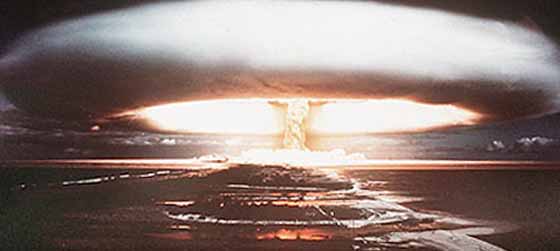
Infant School Memories
The first 'namer' I spotted beginning with a '4' was resting at the buffer stops adjacent to the booking hall at Leeds Wellington Street station. I found the number of 45573 Newfoundland in my Ian Allen abc book listed among the names of countries belonging to the British Commonwealth and, during lessons at Woodside Infants School the following day I mentioned it to my teacher, Miss Frazer; a strict disciplinarian, who called me out in front of the whole class, then marched me to the World Atlas on the classroom wall - "Do you see that large pink part, there, there and there?" she asked.
I couldn't fail but notice. It covered a good third of the map.
"That is the British Empire," she beamed, and gave me a big squeeze.
Now I wasn't sure what she had meant to communicate - pride or tenderness? Her extraordinary show of affection was a far cry from the usual vitriolic ear-bashing she dished out in class. Most of the boys in school 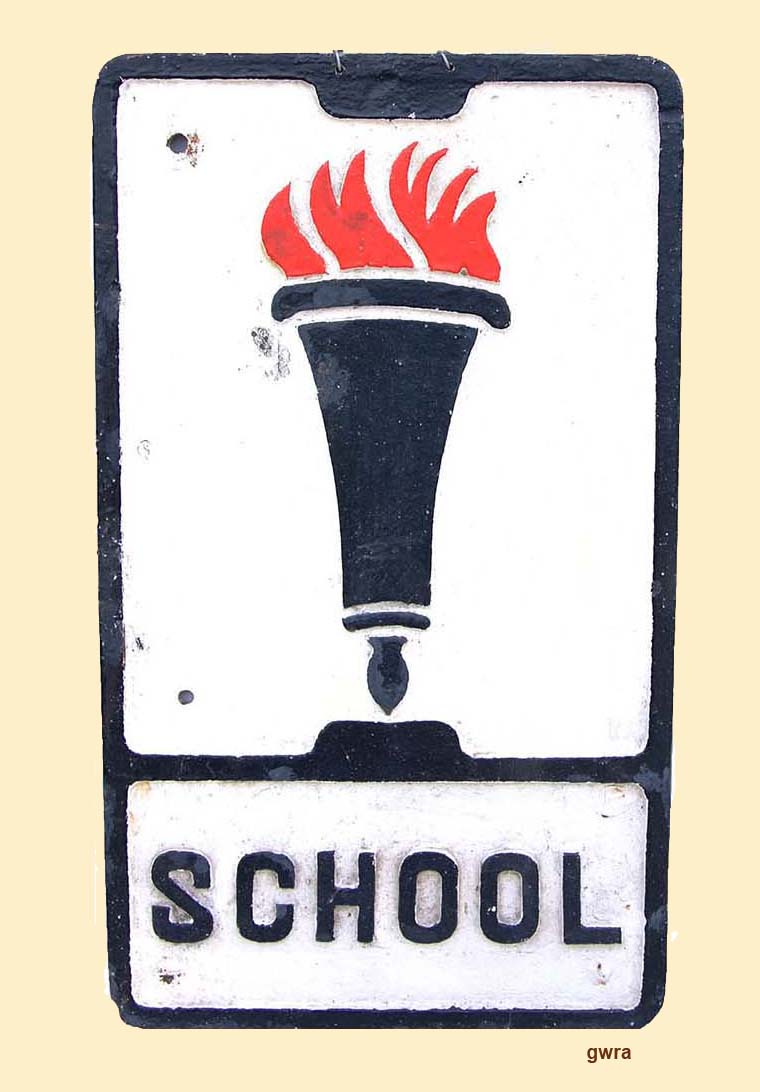 had tried to engage the old battle axe's lasting affection at one time or another, so her fond embrace was a whole new experience for them, and me - and, seizing the moment, I asked her about the bird names among the A4 'streaks'.
had tried to engage the old battle axe's lasting affection at one time or another, so her fond embrace was a whole new experience for them, and me - and, seizing the moment, I asked her about the bird names among the A4 'streaks'.
"Streaks!" she boomed, "I've never heard such nonsense. Spell them out for me."
Who, me? - and in front of the whole class?
Had it been at any other time, I would have feigned unconsciousness and crumpled helplessly to the floor, but I knew all the A4s names by heart, so when she marched me to the blackboard, I managed to spell out Bittern and Mallard flawlessly in joined-up writing without any prompting from her.
I must have made a big impression because she asked me to bring my Ian Allan abc book to school, then devoted a whole afternoon going through the different bird names listed among the Class A1s and A4s, but for some reason she failed to mention the racehorse names of the Class A3s. Perhaps she took a dim view of teaching a class of six-year olds the immoral activities of gambling?
When I asked her about the three engines - Nos 60074, 60084 and 60086 - I'd seen working the 'Queen of Scots' Pullman through Horsforth station, she told me that Thomas Gainsborough was a famous 16th Century painter, and a combined harvester is a machine used by farmers for reaping corn...
"And 'Trigo', Miss?"
"That!" she said indignantly - "Is a silliest name to call an engine."
(For the record, No 60084 Trigo was named after the 1929 Derby and St Leger winner).
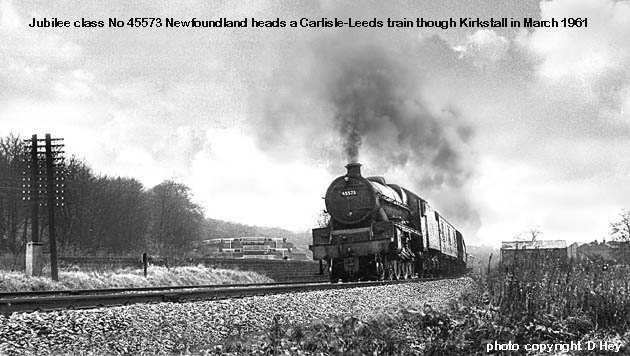
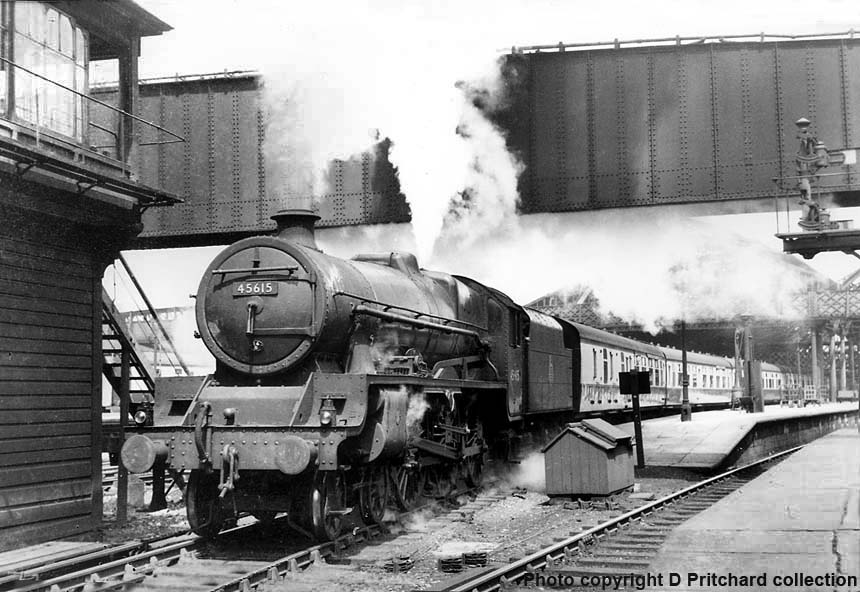

(Above) By way of a change, I must mention the items that appear for sale at the various Railwayana Auctions since they help us appreciate our place in the grand scheme of things, and they prove just how convoluted our railway history really is. This locomotive nameplate measuring 34½" long - 'Bradshaw' - from an LMS 'Patriot' class loco, went under the hammer for £9,000 at a Great Central Railwayana Action on 16th January 2010. Built at Crewe Works in 1933 (as LMS No 6006) the loco was renumbered 5518 the following year. It was named 'Bradshaw' in May 1939 to mark the centenary of the Bradshaw railway timetable publications. For the record, George Bradshaw was an English cartographer, printer and publisher, best known for developing the world's first compilation of railway timetables very soon after the introduction of railways in Britain; the first edition was published on 19th October 1839, costing sixpence - 2½p in today's money - a cloth-bound book entitled 'Bradshaw's Railway Time Tables and Assistant to Railway Travelling'. This rather long-winded title was changed to 'Bradshaw's Railway Companion' in 1840, however the following year a new volume was issued monthly under the title 'Bradshaw's Monthly Railway Guide'. An amusing snippet can be found on Wikipedia's page; evidently between the two World Wars the verb 'to Bradshaw' was a derogatory term referring to pilots in the Royal Air Force whose perceived lack of ability to navigate was betrayed by those who plotted a course by following railway lines! In BR days the 'Patriot' class loco was numbered 45518 and allocated to Carlisle Upperby, Preston, Edge Hill, Warrington, Aston, returning to Edge Hill again and finally Lancaster (Green Ayre) from where it was withdrawn in October 1962. After four months in store at Green Ayre, it was cut up at Horwich Works in February 1963.
(Below) Opened on 1st August 1862, the Pateley Bridge branch diverged from the Harrogate-Ripon line at Ripley Junction and ran along the Nidd Valley to a single-platform terminus at the foot of the main street at Pateley Bridge. The track continued over the level crossing to some sidings serving Scot Gate Ash quarries, and from 1907, this gave a connection to the Nidd Valley Light Railway - a line used for conveying materials to Bradford Corporation's reservoirs, but it was also used for carrying passengers between Pateley Bridge and Lofthouse. During steam days, four trains ran in each direction daily on the Harrogate-Pateley Bridge service, with additional trains on Saturday. Most workings were performed by Wilson Worsdell's Class G5 0-6-0T No 1839, which continued to work the branch as No 67253 until closure in April 1951. No 67253 is seen on the last day of service at Pateley Bridge - goods traffic continued until 1964. Photo © Family Album
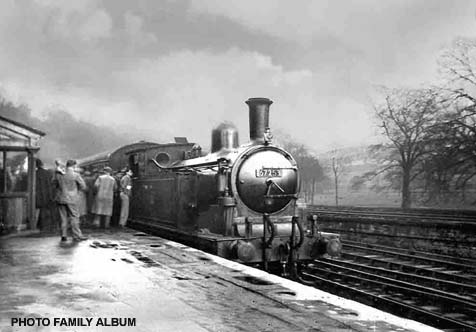
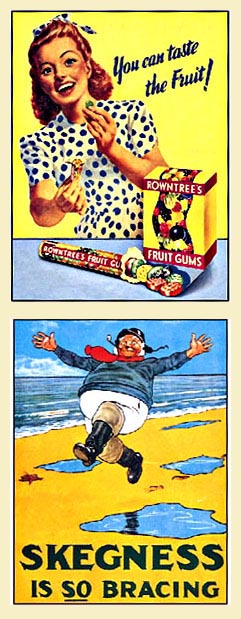 Back in the early 1950s the grass roots of society were very different from what they are today. Marriage was an unbreakable institution and the very foundation upon which society was formed. Instilled in every youngster was an appreciation of traditional family respectability, and an even stronger sense of moral values. Discipline was strict and illegitimacy and swearing were taboo. We were told to eat everything on our plates; not to cheek our elders, and if anyone dared step out of line they'd get a clip behind the ear. Did it do any real harm? Did it 'eck as like!... As for the rest of the Fifties, what can one say? Apart from a schoolboy's love of train spotting (then a national hobby) it's not easy to pick out a representative snap shot of the decade, though it did produce a surprising number of 'giant leaps forward' that we take for granted today. In the medical field, the first polio vaccination was announced, the first heart-lung machine was used in a coronary by-pass operation, scientists cracked the genetic code enabling the analysis of DNA and the first successful kidney transplant took place. The Fifties also produced the first parking meter, the first comprehensive school, the introduction of MOTs - and, last but not least, to commemorate the Coronation of Queen Elizabeth 11 in 1953, school children received a free mug which ended up at the back of millions of post-war utility sideboards.
Back in the early 1950s the grass roots of society were very different from what they are today. Marriage was an unbreakable institution and the very foundation upon which society was formed. Instilled in every youngster was an appreciation of traditional family respectability, and an even stronger sense of moral values. Discipline was strict and illegitimacy and swearing were taboo. We were told to eat everything on our plates; not to cheek our elders, and if anyone dared step out of line they'd get a clip behind the ear. Did it do any real harm? Did it 'eck as like!... As for the rest of the Fifties, what can one say? Apart from a schoolboy's love of train spotting (then a national hobby) it's not easy to pick out a representative snap shot of the decade, though it did produce a surprising number of 'giant leaps forward' that we take for granted today. In the medical field, the first polio vaccination was announced, the first heart-lung machine was used in a coronary by-pass operation, scientists cracked the genetic code enabling the analysis of DNA and the first successful kidney transplant took place. The Fifties also produced the first parking meter, the first comprehensive school, the introduction of MOTs - and, last but not least, to commemorate the Coronation of Queen Elizabeth 11 in 1953, school children received a free mug which ended up at the back of millions of post-war utility sideboards.
But I digress...this page is about childhood spotting days. In fact, watching children playing with toys can reveal a wealth of information about a child's development and the way gender stereotyping is established early on in infancy. Inherent in every girl is a passion for playing with dolls and clip-clopping around the house in mum's high-heeled shoes, whereas boys have an unashamed passion for big machines - and the bigger, noisier and dirtier the better! If I had to run an appraising eye over the big machines I recall as a child - cranes, tipper trucks and diggers; to say nothing of double-decker buses and trams - then nothing could stimulate a rash of goose-pimples in quite the same way as the sight and sound of a hard-working locomotive.
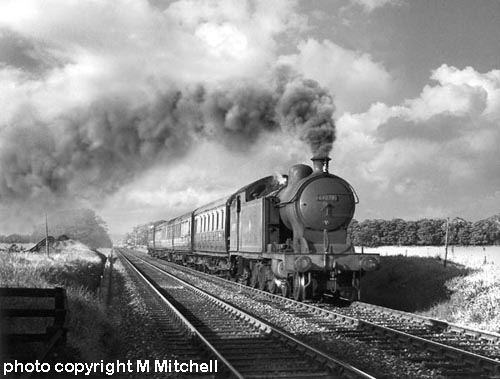
(Above) Mike Mitchell's photo of Class A8 4-6-2T No 69879 heading the 6.25pm Bridlington-Hull at Harpham Crossing, near Burton Agnes on August 1st 1957 reminds me of family holidays to 'Brid' on the Yorkshire coast in the Fifties. Unlike most boys who spent their days on the beach building sand castles, what marked me out as different was a fondness for watching trains at Bridlington railway station. Dozens of excursions would arrive daily, so the expectancy of 'copping' a whole new batch of engines was a thrilling prospect. In those days, train spotting gave a small boy the same rush of excitement that an adrenalin junkie might get from bungy jumping today. For the record, the Class A8 'Pacific' tank engine was a Gresley 1931 rebuild of the old NER 'D' class 4-4-4T type introduced in 1913.
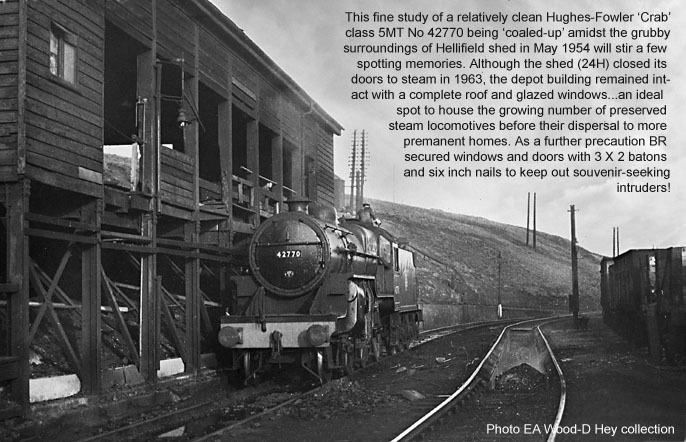
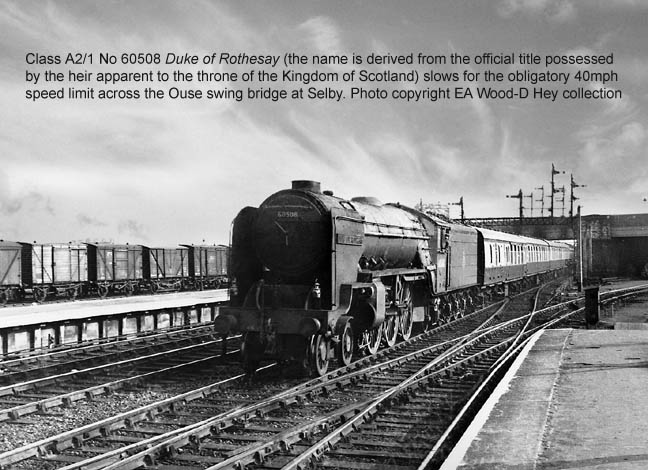
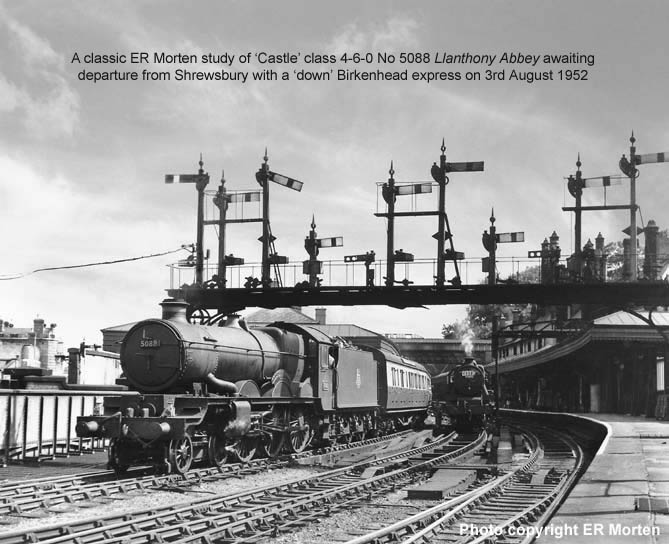
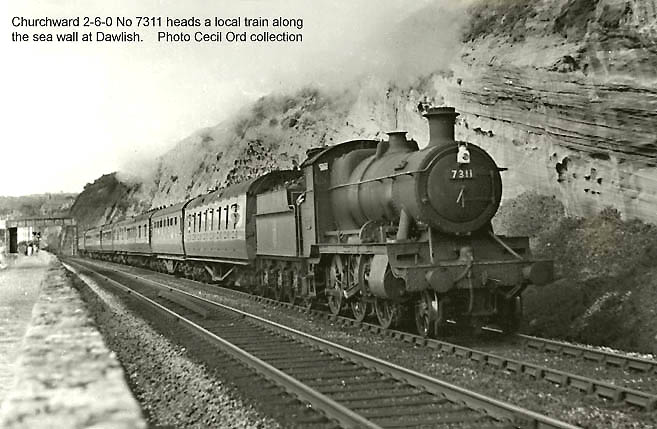

(Below) British Railways numbered the WD 'Austerity' freight locomotives (built to Ministry of Supply design, and working on loan at the time of nationalisation) in the 90,000s.The design and construction of the 'WD' (War Department) 2-8-0s was prepared by R.A. Riddles CBE, then Mechanical and Electrical Engineer for Scotland, LMSR, and attached to the Ministry of Supply as Deputy Director General of Royal Engineering Equipment. The first batch of 'WD' Class were built by the North British Locomotive Company in 1943 for general war service overseas. This was followed by a second batch constructed at the Vulcan Foundry Ltd, and no fewer than 733 returned for service on BR, with 261 going to the London Midland region, 260 to the ER, 109 to the NER, 49 to the WR and 54 to the ScR. Although built for austerity conditions overseas, these locomotives played a vital role in ordinary freight service on British Railways. A classic shot by Jim Carter - an unusually clean 'WD' No 90147 heads a 'down' loose-fitted freight on the WCML at Winwick Junction.
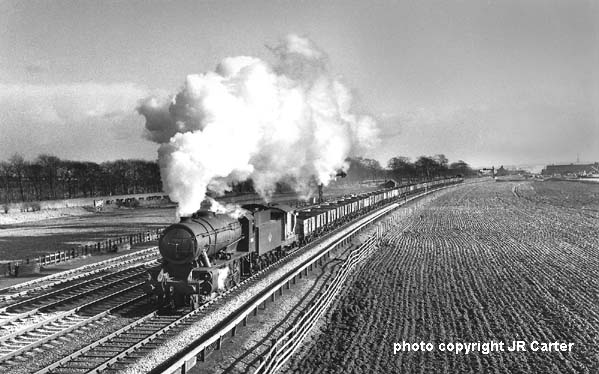
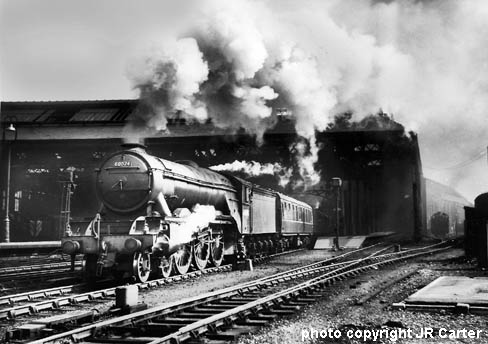
By the mid-1950s, however, the cosy world which had been passed down through generations was about to change when grown-ups actually acknowledged there were teenagers in the world. A new cultural genre burst upon the scene called Teddy Boys, who were fed up of the lovey-dovey ballads sung by Anne Shelton and Donald Peers; they wanted their own brand of music to set them apart from the older generation. The 'Teds' liked to dress up in style, wearing anything from knee-length draped jackets and drainpipe trousers to bootlace ties and crepe-soled shoes. Their dress code was not quite as daring as the 'Beatnik' and 'Punk' 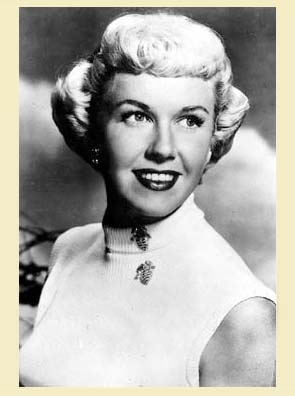 eras to follow, but back in the Fifties the velvet frock coats and brocade collars were Edwardian-style fop at its best. Not only was the Ted's rebellion as bold as you could get in the drab demob days of the 1950s, it was a patent triumph over the older generation; a metaphorical two-fingered salute to the establishment.
eras to follow, but back in the Fifties the velvet frock coats and brocade collars were Edwardian-style fop at its best. Not only was the Ted's rebellion as bold as you could get in the drab demob days of the 1950s, it was a patent triumph over the older generation; a metaphorical two-fingered salute to the establishment.
The girls liked to put on the style too, though their fashions were not quite as daring. Apart from skin-tight jeans, which Marilyn Monroe made famous in the 1954 film 'River Of No Return', the Fifties was probably the last time that a girl wanted to look like her mother. The style was feminine from head to toe, with tight-fitting V-necked sweaters and flowing skirts supported by bouffant paper nylon petticoats stiffened in conventional starch or a strong sugar solution to give the skirt a crinoline puff effect. The girls had perfectly-coiffured hair which spoke loudly of the effort they had made to look feminine; a 'glam' style that emulated the starlet days of Tinseltown Hollywood when films starring Marilyn Monroe and Gina Lollobrigida arrived at our local flea pit. However, the archetypal girl next door in the Fifties was the American film star, Doris Day; who personified a more innocent age - the unimpeachable sweetheart of yesteryear. Boys were just plum crazy about the buckskin-clad tomboy who rode the Deadwood stage right over the hill, whip-cracking away in the western comedy film 'Calamity Jane' with Howard Keel in 1953. I'm harking back to the unsullied days of childhood when our neurotic obsession with a girl's vital statistics had yet to manifest itself in adolescence.
 Then, from America, came a new breed of hero: Marlon Brando, Buddy Holly and James Dean who, after their tragic deaths, were destined to become cult figures. Even today (no matter how long ago the Fifties may now seem) teenagers will always identify with the bespectacled Buddy Holly's music, or the moody James Dean, whose style of 'method' acting brought to vivid life the story of a crazy, mixed-up delinquent in leather jacket, jeans and T-shirt in the film 'Rebel Without a Cause'. Brando and Dean unwittingly spawned a generation of American 'Greasers', as portrayed in the 1970's film 'Grease' starring John Travolta and Olivia Newton John; a throwback to the USA's 1950s youth culture. Here in Britain the American influence generated our own pop heroes: Tommy Steele, Cliff Richard and the Shadows, Adam Faith, Marty Wilde and Billy Fury.
Then, from America, came a new breed of hero: Marlon Brando, Buddy Holly and James Dean who, after their tragic deaths, were destined to become cult figures. Even today (no matter how long ago the Fifties may now seem) teenagers will always identify with the bespectacled Buddy Holly's music, or the moody James Dean, whose style of 'method' acting brought to vivid life the story of a crazy, mixed-up delinquent in leather jacket, jeans and T-shirt in the film 'Rebel Without a Cause'. Brando and Dean unwittingly spawned a generation of American 'Greasers', as portrayed in the 1970's film 'Grease' starring John Travolta and Olivia Newton John; a throwback to the USA's 1950s youth culture. Here in Britain the American influence generated our own pop heroes: Tommy Steele, Cliff Richard and the Shadows, Adam Faith, Marty Wilde and Billy Fury.
(Below) There is a close connection between our sense of smell and memories of steam days, and like the pop songs of yesteryear they can evoke images of a particular moment in the past. I've compiled this guide (below) to BR's new motive power that was introduced during the 1950s and 1960s, along with the Christmas No 1 hits from 1952 (when the British Hit Parade was launched by the 'New Musical Express') to the end of steam days in 1968. It may jog a few memories of your own...
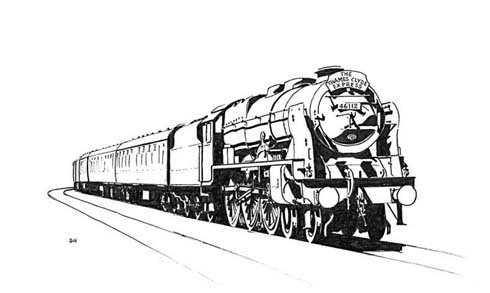
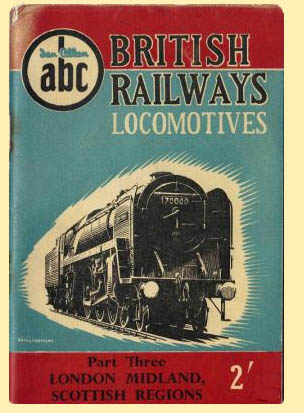 The Fifties was a decade in which parents imposed strict control over children, subscribing to uniformity, not individuality, but as train spotting involved the discipline of collecting numbers the vast majority of grown-ups unanimously accepted the hobby as being some sort of educational tool. Indeed, the hobby appealed to all ages during the Fifties. For example, a major milestone took place on April 20th 1958 when the BBC screened the first 'Railway Roundabout' by John Adams and Patrick Whitehouse. The programme was aimed at children, but rumour has it that thousands of adults secretly dashed home from work to catch the BBC's children's hour...
The Fifties was a decade in which parents imposed strict control over children, subscribing to uniformity, not individuality, but as train spotting involved the discipline of collecting numbers the vast majority of grown-ups unanimously accepted the hobby as being some sort of educational tool. Indeed, the hobby appealed to all ages during the Fifties. For example, a major milestone took place on April 20th 1958 when the BBC screened the first 'Railway Roundabout' by John Adams and Patrick Whitehouse. The programme was aimed at children, but rumour has it that thousands of adults secretly dashed home from work to catch the BBC's children's hour...
As for train spotter's fashions? By the very nature of the hobby, boys donned sensible pullovers, knee- length short trousers, or thick denim jeans with turn-ups (turned down as legs grew longer) and duffel coats fastened by wooden pegs instead of buttons and, dare I say it - anoraks - ouch! Of course, boys still liked to play games of fifteen-a-side soccer and a marathon round of hop-scotch in the street, but as soon as we developed an irresistible urge to swap and collect - birds eggs, used stamps, old coins, and cigarette cards - then it was only natural that engine numbers figured high on our list of priorities. Even better, it didn't require a huge financial commitment, which made all the difference in the post-war Fifties. It probably explains why hard-up parents gave the hobby a universal thumbs-up.
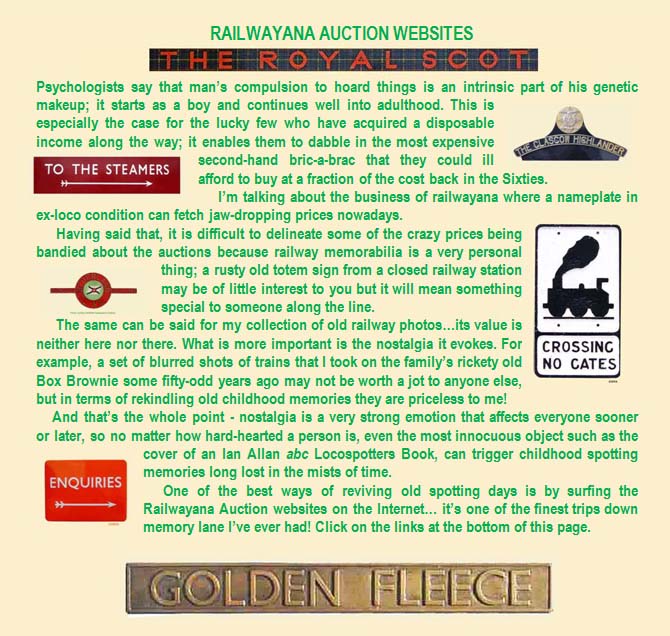 By contrast with today, the Fifties was an era of optimism. Food and rationing had just lifted, raising the nation's mood. The average wage of a working man was £10 17s 5d a week (£10.87) - around £205 in today's money. A white loaf cost 7d (about 3p) and a pint of milk 7d. Women's fashions became more extravagant. Full-skirted dresses with stiffened petticoats, while scarlet lipstick and make-up was applied pancake-thick. Sir Winston Churchill was replaced as Prime Minister by Foreign Secretary Sir Anthony Eden in 1955 - also that year Newcastle United beat Manchester City 3-1 in the FA Cup Final at Wembley.
By contrast with today, the Fifties was an era of optimism. Food and rationing had just lifted, raising the nation's mood. The average wage of a working man was £10 17s 5d a week (£10.87) - around £205 in today's money. A white loaf cost 7d (about 3p) and a pint of milk 7d. Women's fashions became more extravagant. Full-skirted dresses with stiffened petticoats, while scarlet lipstick and make-up was applied pancake-thick. Sir Winston Churchill was replaced as Prime Minister by Foreign Secretary Sir Anthony Eden in 1955 - also that year Newcastle United beat Manchester City 3-1 in the FA Cup Final at Wembley.
Since then, the standard of living has improved beyond all recognition, yet relatively little has changed in a child's development. The same irresistible urge to collect things is inherent in all boys at some stage in their lives, and whilst some erstwhile 'crazes' may come and go - hoola-hoops, yo-yos, po-gos, even space hoppers - certain crazes can become so deeply entrenched in our affections that they will never go away…like train spotting, for instance?
I suppose only time will tell if the splatter-happy violence of today's computer games will remain as popular with the next generation. What we do know, however, is that a boy's interest in trains will always stand the test of time and no amount of anorak-baiting can change that fact.
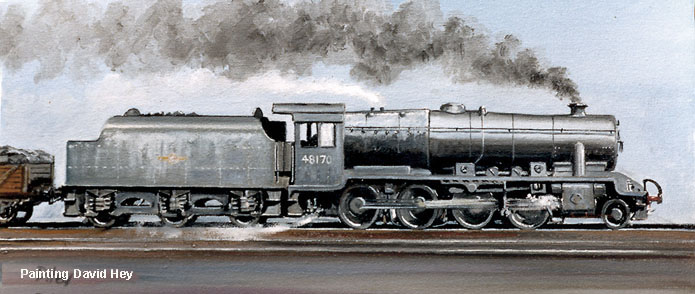
Great Central Railwayana Auctions....click here.
GW Railwayana Auctions.....................click here.
Sheffield Railwayana Auctions............click here
Polite notice: All text and photographs are protected by copyright and reproduction is prohibited without the prior consent of the © owners. If you wish to discuss using the contents of this page the email address is below. Please note - this is not a 'clickable' mail-to link via Outlook Express. You will have to email manually.
dheycollection@ntlworld.com



